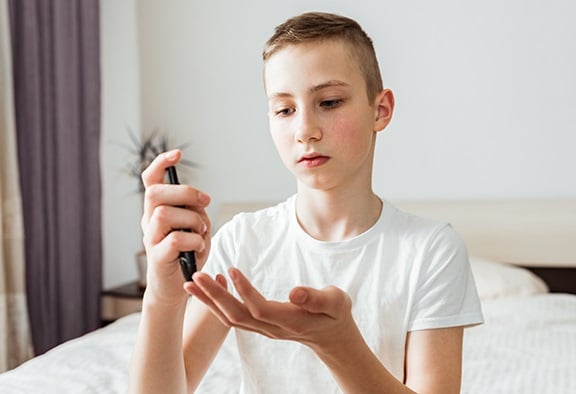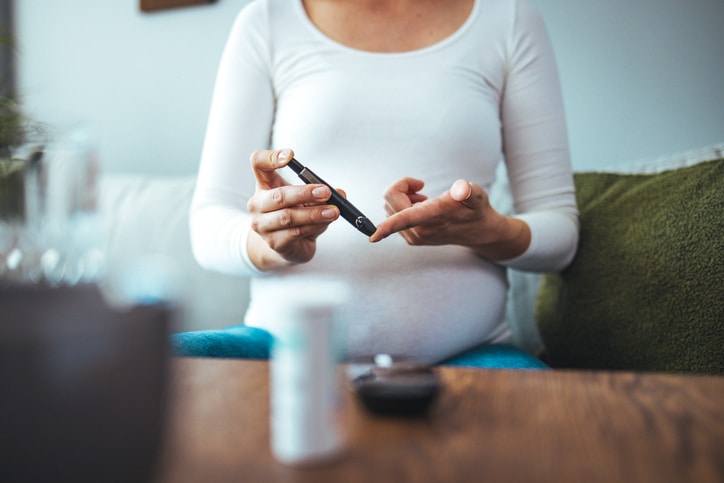
Getting a diabetes diagnosis can be an unpleasant surprise, but you’ll still be able to live a fulfilling life – all you have to do is make a few lifestyle changes. Here’s everything you need to know about living with diabetes.

Written by: ADS Staff
Clinically Reviewed by: Halle Elbling, MS, RDN, CDCES
Have you just been diagnosed with diabetes? If so, it’s understandable if you’re confused, overwhelmed, or even in shock. But you’re not alone – about 1.5 million people are diagnosed with some form of this disease each year.
The good news about diabetes management is that a few simple steps can go a long way. In this article, we’ll give you the rundown on what to do when you’ve just been diagnosed with this disease.
Know More About Your Diabetes Diagnosis
First of all, it’s essential to understand that “diabetes” isn’t a single disease. Instead, there are four types of diabetes, and they are each treated differently. As a result, the first step in your diabetes management journey should be learning more about the variety of diabetes you have.

Type 1 Diabetes
If you have a type 1 diabetes diagnosis, your diabetes symptoms are tied to issues with your body’s ability to make insulin. The human pancreas is ordinarily responsible for producing insulin, which helps glucose in your bloodstream enter the cells that use it as a fuel source. When the pancreas can’t do its job, and no insulin is produced glucose builds up in your blood instead.
Some of the most common type 1 diabetes symptoms include blurry vision, frequent urination, excess thirst/hunger, and unusual mood swings. Potential complications of this disease include heart disease, neuropathy, and difficulties with pregnancy.
To treat type 1 diabetes, you’ll need to use insulin every day – this medication can be delivered with an insulin pump or a regular needle. Along with that, you should use a glucose meter to check your blood sugar levels throughout the day. Or a Continuous Glucose Monitoring system or CGM can be a great option too.
Type 2 Diabetes
Unlike people with type 1 diabetes, many people who have a type 2 diabetes diagnosis produce the insulin they need. Despite this, their bodies have trouble using insulin effectively, a condition known as “insulin resistance.” The pancreas produces more insulin than before in response until it can no longer keep up.
Most type 2 diabetes symptoms are similar to those seen in type 1 diabetes, but they can sometimes develop more slowly. Some complications people with type 2 diabetes should be aware of are dementia, skin problems, organ and nerve damage, and sleep apnea.
Although some people who have type 2 diabetes have to use insulin and medications to treat this disease effectively, that is not the case for everyone who has this disease. You may be able to keep your type 2 diabetes under control by getting physical activity, following a balanced diet, and making other healthy lifestyle changes.

Gestational Diabetes
A gestational diabetes diagnosis is unique because it only affects pregnant women and usually goes away after they give birth. This type of diabetes seems to have links to hormonal changes during pregnancy, which can affect blood sugar levels in the human body.
Shortly after you become pregnant, your doctor will test you for gestational diabetes. That’s due in large part to the fact that this condition often does not come with noticeable symptoms. Still, diagnosing and treating gestational diabetes is crucial, as its complications can affect both you and your baby.
Treatment of gestational diabetes involves monitoring blood sugar, getting moderate amounts of physical activity, and eating a balanced diet. You may also need insulin therapy to keep your blood sugar under control during pregnancy.
Prediabetes
Strictly speaking, prediabetes isn’t a form of diabetes, but it’s so closely related to this disease that it bears mentioning here. If you have prediabetes, your blood sugar levels are above average but have not reached the point where you could be diagnosed with type 2 diabetes.
If you’ve been diagnosed with prediabetes, you still have a chance to avoid a type 2 diabetes diagnosis later on in life. Focus on losing weight, getting more physical activity, not smoking, and making some dietary changes like eating fresh vegetables and fruits, nuts and whole grains to lower your type 2 diabetes risk.
Manage Diabetes with Lifestyle Changes
The exact nature of your diabetes treatment strategy will differ based on the type of diabetes you have. However, some things – namely, dietary changes and exercise – will always help you keep your blood glucose levels in check.
Physical Activity
Getting active can improve anyone’s health, but it’s imperative if you have diabetes or prediabetes. Regular exercise can help lower your blood sugar, increase your “good” (HDL) cholesterol, cut down on your “bad” (LDL) cholesterol, relieve stress, and reduce your blood pressure.
When creating an exercise regimen, it’s essential to make sure you know what you’re doing first. That might mean taking an exercise stress test to ensure you’re not getting more physical activity than you can handle. You’ll also need to learn how exercise can affect your blood sugar and have fast-acting carbs on hand if your blood glucose levels get too low.
Once you’ve taken these precautions, it’s a good idea to focus on getting 20-45 minutes of exercise on most days of the week. Start slow and gradually increase the intensity of your workouts from there.

Dietary Changes
A healthy diabetes diet doesn’t need to look like the keto diet or another fad diet. Instead, most people with diabetes should eat a balanced diet with reasonable portions of foods chosen with their diagnosis in mind.
You’ll want to work with a Registered Dietitian Nutritionist along with your healthcare team when building your diabetes meal plant, but these tips can help you get started:
- While produce contains carbohydrates, it’s also full of valuable vitamins, nutrients and fiber. With that in mind, feel free to eat the recommended servings of fruits and veggies.
- For proteins, stick to lean cuts of meat and get at least some protein from plant-based sources.
- Although you don’t need to avoid carbs, your best bet is to eat small portions of whole-grain foods like oatmeal and brown rice.
- Try to avoid eating processed grains, fast food, sweets, oils, and saturated fats.
- Avoid sweetened and high sugar beverages and juices.
- Do not skip meals.
Find a Community of People with Diabetes
So far, we’ve focused on your physical health – but managing your mental health is necessary, too. Like any chronic disease, dealing with a diabetes diagnosis can be overwhelming. But knowledge is power, and reading books or online articles (including the articles featured on this very blog) can help.
Since diabetes is such a common diagnosis these days, it shouldn’t be too hard for you to find a community of people facing the same challenges you are. Ask your healthcare team if there are any diabetes support groups in your area, or maybe look for private groups for people living with diabetes for example like on Facebook.
Facebook Pages for Diabetes Community
Facebook Groups for Diabetes Community
Get Your Diabetes Supplies From ADS
If you’ve just recently gotten a diabetes diagnosis, there’s a good chance you’re still figuring out what supplies you need to keep this disease in check. But you also need to make sure you’re getting these products from a reliable source.
At ADS, we focus on providing reliable diabetes supplies to customers across the country. We can help you get whatever supplies you need, including insulin, insulin pumps, diabetes testing supplies, CGM’s and glucose meters. Find out more about the products ADS can deliver by visiting our online store today!
